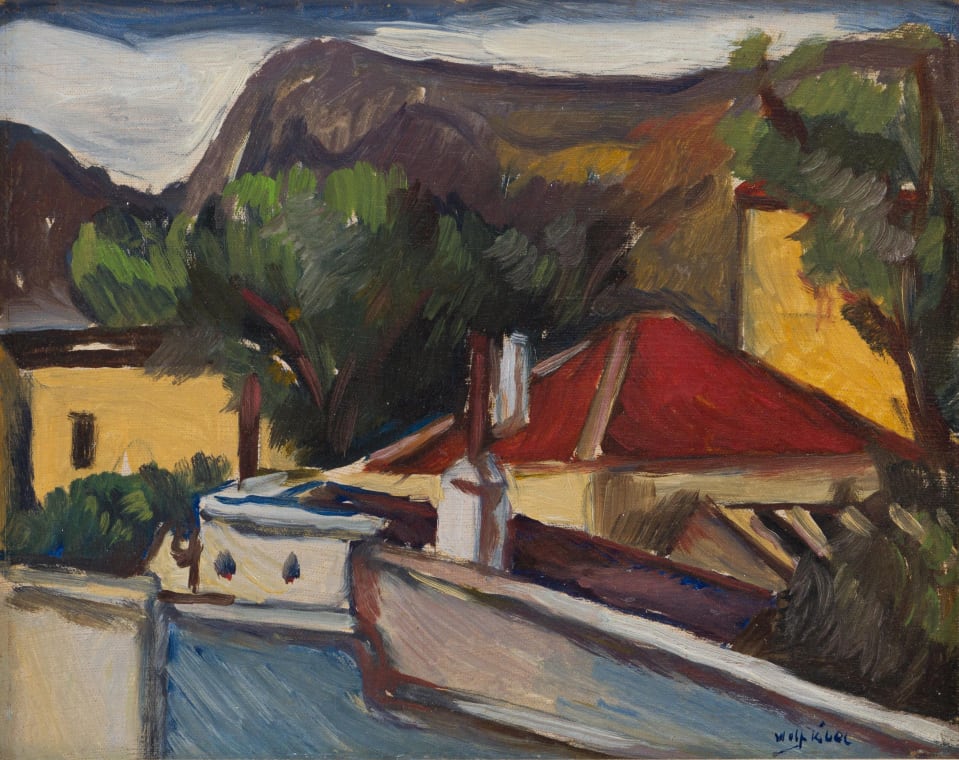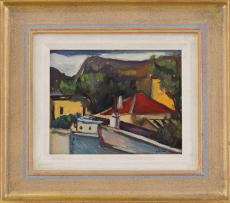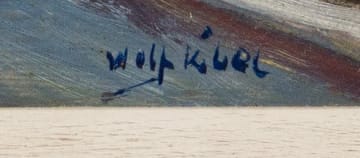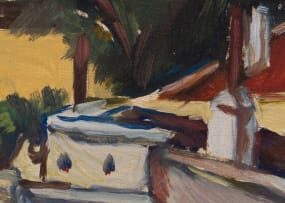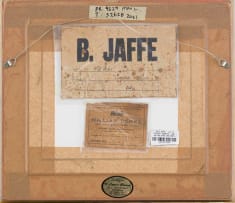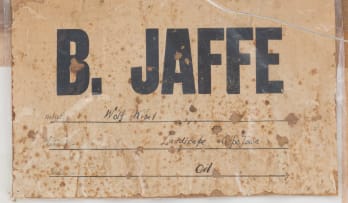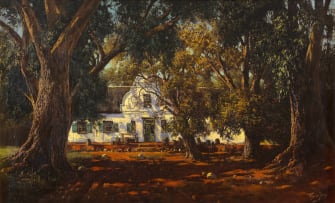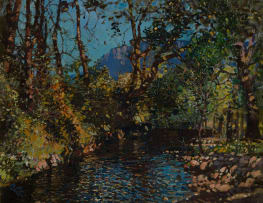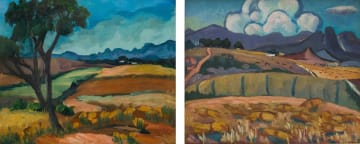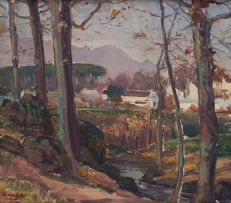Modern, Post-War and Contemporary Art
Live Virtual Auction, 17 - 18 May 2021
Modern, Post-War and Contemporary Art
Incl. Buyer's Premium & VAT
About this Item
signed; inscribed with the artist's name on a B Jaffe label adhered to the reverse
Notes
Wolf Kibel spent most of the last nine years of his life, between 1929 and 1938, living in Cape Town at 'Palm Studios', a dilapidated house on Roeland Street, with a single, forlorn date palm tree in the front yard. His studio was on the upper storey, and the sculptor Lippy Lipschitz worked next door. One of Kibel's most striking paintings from this time is View from My Studio, currently in the Sanlam Art Collection. It shows a foreshortened studio interior with two door panels opening onto the rooftops of the city that lies to the north of the house. Kibel's studio also had a good view of the rooftops of the Malay Quarter to the west. The present lot depicts another rooftop scene in Cape Town. The interior/exterior duality was always present in Kibel's work, with the outdoors being especially captivating for him. He was not really interested in grand facades and imposing buildings, but rather in inconspicuous street scenes, and unassuming backyards, courtyards and rooftops.
Why this interest of Kibel's in rooftops? How did the subject settle so comfortably in his mind, becoming a source of inspiration for many of his best paintings?
The answer is probably found in a closer look at the artist's life and the manner that rooftops became part of the usual observation of his immediate physical surroundings, observations that could possibly have settled in his subconsciousness, founding a visual outlet for his striking rooftop paintings.
Born in Grodzisk, near Warsaw, Poland in 1903, Kibel was surrounded by crammed buildings with small living spaces stacked on top of each other in the Jewish ghetto, a similar living arrangement he experienced when he was apprenticed in the neighbouring village of Kutna in 1911, and later in the ghetto in Vienna, where he fled in 1923 to escape conscription into the military. In 1925 he relocated to Israel, living in an ancient, deserted monastery just outside Jerusalem. Kibel, along with all the other homeless people who occupied the place at night, had to scale the high wall surrounding the monastery, which gave him a fascinating view of the rooftops of nearby Jerusalem. Even when he moved to Tel Aviv later that year, the studio he occupied in Bialik House gave him a clear view of the rooftops of the city below.
Kibel had always wanted to study in Paris. In Palestine, he met various artists who had studied in Paris and who brought back tales of fabulous artists such as Paul Cézanne, Marc Chagall, Henri Matisse and Chaim Soutine. Up until then, Kibel had only had the privilege of meeting Oscar Kokoschka in Vienna. Knowledge of Cézanne's cubist approach to form and composition was a great influence on Kibel's subsequent work, as were Matisse's fauvist use of colour, Chagall's poeticism, and Soutine's expressive brushstrokes. Kibel distilled a unique style of all this visual inspiration. Harold Jeppe aptly remarks: 'Subject matter and its correlation with previous styles constitutes a false premise on which to judge an artist's individuality: no artist is independent of his predecessors.'1 Kibel's interest in the formal qualities of painting led his wife Freda to observe that his art was essentially about 'the absolute maximum of expressiveness extracted from the minimum of material.'2 She also observed that Kibel's lifelong quest personally and artistically was 'to keep a roof over our heads'.3
Such artists as Hugo Naudé, Maggie Laubser, Cecil Higgs and Lippy Lipschitz were quick to embrace a fellow modernist in this country, but the general art community in the Cape was initially very sceptical about Kibel's work. His inclusion in the Empire Exhibition of 1936 helped to win them over, but it was the indefatigable endeavours of his wife after his death, organising numerous memorial and retrospective exhibitions, that kept Kibel in the public imagination until the 1970s.4 Sadly, a whole generation of art lovers missed out on Kibel's artistic sensibilities and the present lot is the ideal opportunity to admire and reassess his merits as one of our foremost South African modernists.
1. Harold Jeppe (1964) 'Wolf Kibel 1903-1939', Lantern, XIII (3), page 38.
2. Freda Kibel (1968) Wolf Kibel: A Brief Sketch of his Life and Work, Cape Town: Human & Rousseau, page 28.
3. Ibid, page 22.
4. 1942: Memorial exhibition, Cape Town; 1947: Memorial exhibition, Johannesburg; 1950: Memorial exhibition, Cape Town and Johannesburg; 1963: Memorial exhibition, Johannesburg; 1965: Memorial exhibition, Pretoria; 1976: touring retrospective exhibition at the South African National Gallery, Cape Town, William Humphreys Art Gallery, Kimberley, Pretoria Art Museum, Johannesburg Art Gallery, Tatham Art Gallery, Pietermaritzburg, Durban Art Museum, and King George VI Art Gallery, Port Elizabeth.
Provenance
Ben Jaffe Collection.
